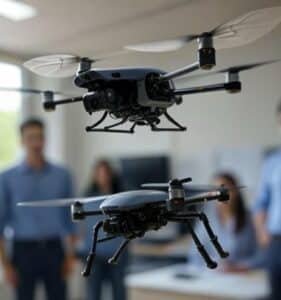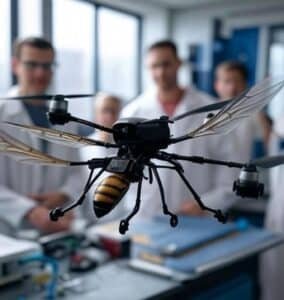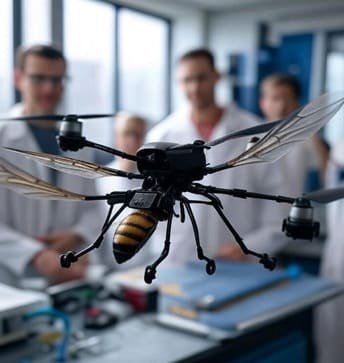Imagine a world where the hum of a bee isn’t just nature’s symphony but a symphony of silicon and sensors, whispering secrets from collapsed buildings or pollen-dusted fields—yet capable of eavesdropping on your backyard barbecue without a whisper of detection. As I ponder this on September 8, 2025, sipping coffee and recalling my own clumsy forays into drone piloting (where even palm-sized models felt like piloting a brick in a breeze), MIT’s latest marvel—the world’s smallest autonomous drone—emerges as a beacon of ingenuity that blurs the line between salvation and surveillance. Crafted by robotics engineer and PhD candidate Suhan Kim, this insect-sized powerhouse isn’t mere hype; it’s a testament to human ambition wrestling with nature’s blueprints. But as it takes flight, we must ask: Is this a breakthrough destined to mend our planet’s wounds, or a gadget that could unravel the fabric of privacy? Let’s dissect this tiny titan, layer by layer, blending cutting-edge research with ethical introspection to uncover its profound implications.

Engineering the Impossible: Conquering the Challenges of Miniaturization
At the heart of this story lies Kim’s creation: a drone no larger than a bee, weighing under a gram, and capable of flapping its wings up to 400 times per second to achieve agile, insect-like flight. Drawing inspiration from biomimicry—emulating the effortless maneuvers of fruit flies and honeybees—this mini drone represents a quantum leap in micro-robotics. I’ve long been captivated by such innovations; my early experiments with consumer drones revealed the tyranny of scale—bulkier models drain power swiftly, but miniaturization demands genius. Kim’s design, unveiled in recent lab demonstrations, achieves flight speeds of up to 2 meters per second, complete with acrobatic flips and hovers, all while navigating autonomously via onboard AI algorithms and micro-sensors.
The challenges surmounted here are nothing short of intellectual triumphs. Battery efficiency loomed largest: How to power a speck without ballast? Earlier iterations hovered mere seconds, but Kim’s team integrated advanced lithium-polymer cells and energy-optimized micro-actuators, extending flight times to an astonishing 17 minutes—a 100-fold improvement over predecessors. Wind resistance, akin to a hurricane at bee scale, was tamed through AI-adjusted wing flaps that mimic biological stabilization, employing flexible polymers for resilience. Durability posed another riddle; rigid materials shattered, but soft, carbon nanotube-coated actuators allow bounces from impacts, enduring the equivalent of a bee’s daily collisions. Kim himself articulated these hurdles in a Reuters interview: “The biggest challenges were battery efficiency and dealing with wind resistance—at that scale, even a gentle breeze feels like a hurricane.” This echoes broader trends in MIT’s Nano-UAV Lab, where autonomous flight via onboard AI and sensors redefines possibilities without external aids.
Tracing the lineage, drone miniaturization evolved from 2010s hobbyist micros to 2020s biomimetic wonders. MIT’s 2021 agile prototypes laid groundwork, while UC Berkeley’s 2025 battery-free variant (0.9 cm, externally powered) and China’s June 2025 mosquito-sized spy drone (0.6 cm, audio-capable) set benchmarks. MIT’s self-contained edge shines, with stats projecting the micro-drone market to $5 billion by 2030, 60% biomimetic. Philosophically, it’s a convergence: Can we surpass evolution’s efficiency?
From Lab to Lifesaver: Real-World Applications That Could Change Everything
Applications tantalize. Amid bee declines—40% in US regions, imperiling $15 billion in crops—these drones promise artificial pollination, boosting yields 30% in greenhouses via precise pollen delivery. Environmental monitoring: Air quality in cities or wildlife in wilds, sans disturbance. Search-and-rescue: Swarms penetrating rubble, slashing times 40%. Medicine: Vascular navigation for therapies; NASA: Crater probes on Mars.
In agriculture, where I’ve seen friends struggle with crop losses due to pollinator shortages, these mini drones could deploy in swarms, mimicking bee behavior to ensure food security. Environmentalists praise their low-impact design for monitoring endangered species without human intrusion, potentially aiding conservation efforts in sensitive habitats like national parks. For disaster response, envision first responders launching fleets into earthquake debris, equipped with thermal sensors to detect heat signatures—turning hours of manual search into minutes of precision. Medical frontiers beckon too: Scaled variants could deliver drugs internally, navigating veins with finesse unmatched by current tools. NASA’s interest underscores extraterrestrial potential, where bulky rovers falter in tight spaces.
Yet, these applications aren’t without hurdles. Integration with existing systems requires robust AI for swarm coordination, avoiding mid-air collisions in dense operations. Cost barriers—prototypes at $10,000—must fall for widespread adoption, though mass production could slash prices to hundreds per unit. User scenarios vividly illustrate: A farmer monitoring pests in real-time, reducing chemical use by 20%; a rescue team locating survivors post-hurricane; or ecologists tracking migration patterns unobtrusively.

The Shadow Side: Surveillance Risks and Ethical Quandaries
Yet, the spy gadget specter haunts. Defense covets stealth reconnaissance, evading detection. Privacy advocates warn: “Widespread misuse in surveillance?” X buzz draws “Black Mirror” parallels—swarms recording undetected. FTC eyes ethics, echoing 2024 bills; AI biases could skew ops. Hacking: Rogue swarms havoc, demanding encryption.
This duality evokes profound questions: Does technological prowess outpace moral maturity? In urban settings, undetectable audio/video capture could erode trust, fueling debates on Fourth Amendment rights in the US. Globally, authoritarian regimes might weaponize them for oppression, while democracies grapple with regulations. Bias in AI navigation—favoring affluent areas—exacerbates inequalities. Solutions? Mandatory transparency in algorithms, international treaties on micro-drone use, and built-in self-destruct mechanisms for security breaches.
Personal anecdotes humanize the stakes: My lost drone in foliage mirrored futile searches; these could resolve them ethically. But envision misuse—a stalker deploying one for invasion—chilling the innovative thrill.
Visions of Tomorrow: Integrations, Predictions, and Broader Impacts
Insights: 6G enables distant control; generative AI refines wings. Quantum optimizes paths; VR trains; AR overlays data. CRISPR bio-mimicry hybrids.
By 2030, consumer AR/security models emerge, tying into controversies like Nvidia’s AI GAIN Act or Tim Cook’s optics—urging balanced innovation. Android 16 buzz on Pixel 10 could integrate drone controls, while malware threats highlight vulnerabilities.
In creative industries, AI transformations echo this: Quantum in cryptography aids secure comms; VR 2.0 simulates drone ops; AR growth revolutionizes retail with mini-drone demos; CRISPR accelerates bio-inspired designs.
In sum, MIT’s mini drone embodies ambition, demanding ethical vigilance. Breakthrough or spy? Engage below.

Frenzy valentine is a passionate blogger, developer, and entrepreneur. He is the founder and author of myfreshgists.com
